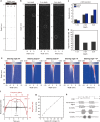Patch-type capacitive micromachined ultrasonic transducer for ultrasonic power and data transfer
- PMID: 40523890
- PMCID: PMC12170874
- DOI: 10.1038/s41378-025-00967-7
Patch-type capacitive micromachined ultrasonic transducer for ultrasonic power and data transfer
Abstract
Ultrasonic power and data transfer is a promising technology for implantable medical devices because of its non-invasiveness, deep penetration depth, and potential for a high-power transmission rate with a low specific absorption rate. However, ultrasound-powered implantable devices still suffer from low power transfer efficiency due to beam misalignment and are limited to short-term use due to the bulkiness of the transmitting transducers. Here, we report the first proof of concept for adaptive positioning and targeting of ultrasound-based implantable devices through ultrasound image guidance. A lightweight patch-type ultrasonic transducer array is fabricated to enable ultrasound imaging and beam-forming during long-term operation. The uniform performance of the array is established through the silicon micromachining process. We demonstrate the complete scheme of imaging, positioning, and targeted power transfer in an ex vivo environment, achieving precise targeting of moving implanted devices through real-time ultrasound imaging. Enhanced power transfer efficiency through the use of patch-type ultrasonic transducers can enhance patient comfort and minimize invasive procedures, opening new applications for ultrasonic-powered implantable devices.
© 2025. The Author(s).
Conflict of interest statement
Conflict of interest: The authors declare no competing interests.
Figures





Similar articles
-
Assessing the comparative effects of interventions in COPD: a tutorial on network meta-analysis for clinicians.Respir Res. 2024 Dec 21;25(1):438. doi: 10.1186/s12931-024-03056-x. Respir Res. 2024. PMID: 39709425 Free PMC article. Review.
-
Ultrasonic Evaluation of Laser Scanning Speed Effect on the Spectral Properties of Three-Dimensional-Printed Metal Phononic Crystal Artifacts.3D Print Addit Manuf. 2024 Jun 18;11(3):e1087-e1099. doi: 10.1089/3dp.2022.0259. eCollection 2024 Jun. 3D Print Addit Manuf. 2024. PMID: 39359574 Free PMC article.
-
Molecular feature-based classification of retroperitoneal liposarcoma: a prospective cohort study.Elife. 2025 May 23;14:RP100887. doi: 10.7554/eLife.100887. Elife. 2025. PMID: 40407808 Free PMC article.
-
Surveillance for Violent Deaths - National Violent Death Reporting System, 50 States, the District of Columbia, and Puerto Rico, 2022.MMWR Surveill Summ. 2025 Jun 12;74(5):1-42. doi: 10.15585/mmwr.ss7405a1. MMWR Surveill Summ. 2025. PMID: 40493548 Free PMC article.
-
3D printing chronicles in medical devices and pharmaceuticals: tracing the evolution and historical milestones.J Biomater Sci Polym Ed. 2024 Dec;35(17):2723-2766. doi: 10.1080/09205063.2024.2386222. Epub 2024 Aug 5. J Biomater Sci Polym Ed. 2024. PMID: 39102337 Review.
References
-
- Chappel, E. In Drug Delivery Devices and Therapeutic Systems. 129–156 (Elsevier, 2021).
-
- Faro Barros, J., Sahraoui, P. F., Kalia, Y. N. & Lapteva, M. In Targeted Drug Delivery, 349–387 (Wiley, 2022).
-
- Afari, M. E., Syed, W. & Tsao, L. Implantable devices for heart failure monitoring and therapy. Heart Fail. Rev.23, 935–944 (2018). - PubMed
-
- Fatima, K. et al. Long-term efficacy of spinal cord stimulation for chronic primary neuropathic pain in the contemporary era: a systematic review and meta-analysis. J. Neurosurg. Sci. 68, 128–139 (2023). - PubMed
LinkOut - more resources
Full Text Sources
